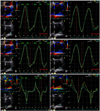1. Krahn AD, Manfreda J, Tate RB, Mathewson FA, Cuddy TE. The natural history of atrial fibrillation: incidence, risk factors, and prognosis in the Manitoba follow-up study. Am J Med. 1995. 98:476–484.
2. Allessie MA, Boyden PA, Camm AJ, et al. Pathophysiology and prevention of atrial fibrillation. Circulation. 2001. 103:769–777.
3. van Wagoner DR, Nerbonne JM. Molecular basis of electrical remodeling in atrial fibrillation. J Mol Cell Cardiol. 2000. 32:1101–1117.
4. Allessie MA. Atrial electrophysiological remodeling: another vicious circle? J Cardiovasc Electrophysiol. 1998. 9:1378–1393.
5. Ravelli F, Allessie M. Effects of atrial dilatation on refractory period and vulnerability to atrial fibrillation in the isolated Langendorff-perfused rabbit heart. Circulation. 1997. 96:1686–1695.
6. Schnee JM, Hsueh WA. Angiotensin II, adhesion, and cardiac fibrosis. Cardiovasc Res. 2000. 46:264–268.
7. Ruiz-Ortega M, Lorenzo O, Ruperez M, et al. Role of the renin-angiotensin system in vascular diseases: expanding the field. Hypertension. 2001. 38:1382–1387.
8. Willems R, Sipido KR, Holemans P, Ector H, van de Werf F, Heidbuchel H. Different patterns of angiotensin II and atrial natriuretic peptide secretion in a sheep model of atrial fibrillation. J Cardiovasc Electrophysiol. 2001. 12:1387–1392.
9. Pedersen OD, Bagger H, Kober L, Torp-Pedersen C. Trandolapril reduces the incidence of atrial fibrillation after acute myocardial infarction in patients with left ventricular dysfunction. Circulation. 1999. 100:376–380.
10. Chung MK, Martin DO, Sprecher D, et al. C-reactive protein elevation in patients with atrial arrhythmias. Circulation. 2001. 104:2886–2891.
11. Hwang SJ, Kim BJ, Shin HS, et al. Assessment of factors influencing plasma BNP level in patients with chronic atrial fibrillation and preserved left ventricular systolic function. Korean Circ J. 2005. 35:605–612.
12. Hatle L, Sutherland GR. Regional myocardial function: a new approach. Eur Heart J. 2000. 21:1337–1357.
13. Cho KI, Lee HG, Kim TI, et al. Quantitative assessment of left atrial function changes in patients with atrial fibrillation by tissue Doppler strain and 2-dimensional strain imaging. Korean Circ J. 2006. 36:786–793.
14. Korinek J, Wang J, Sengupta PP, et al. Two-dimensional strain: a Doppler-independent ultrasound method for quantitation of regional deformation: validation in vitro and in vivo. J Am Soc Echocardiogr. 2005. 18:1247–1253.
15. Barbier P, Alioto G, Guazzi MD. Left atrial function and ventricular filling in hypertensive patients with paroxysmal atrial fibrillation. J Am Coll Cardiol. 1994. 24:165–170.
16. Sutherland GR, Hatle L, Rademakers FE, et al. Doppler Myocardial Imaging: A Textbook. 2003. Leuven, Belgium: Leuven University Press;99–107.
17. Di Salvo G, Pacileo G, Del Giudice EM, et al. Atrial myocardial deformation properties in obese nonhypertensive children. J Am Soc Echocardiogr. 2008. 21:151–156.
18. Thomas L, Levett K, Boyd A, Leung DY, Schiller NB, Ross DL. Changes in regional left atrial function with aging: evaluation by Doppler tissue imaging. Eur J Echocardiogr. 2003. 4:92–100.
19. Di Salvo G, Caso P, Lo Piccolo R, et al. Atrial myocardial deformation properties predict maintenance of sinus rhythm after external cardioversion of recent-onset lone atrial fibrillation: a color Doppler myocardial imaging and transthoracic and transesophageal echocardiographic study. Circulation. 2005. 112:387–395.
20. Hobbs WJ, van Gelder IC, Fitzpatrick AP, Crijns HJ, Garratt CJ. The role of atrial electrical remodeling in the progression of focal atrial ectopy to persistent atrial fibrillation. J Cardiovasc Electrophysiol. 1999. 10:866–870.
21. Hwang GS, Kim YH, Lee HS, et al. Electrophysiologic properties of the atrium in patients with chronic and paroxysmal atrial fibrillation. Korean Circ J. 2000. 30:448–456.
22. Frustaci A, Chimenti C, Bellocci F, Morgante E, Russo MA, Maseri A. Histological substrate of atrial biopsies in patients with lone atrial fibrillation. Circulation. 1997. 96:1180–1184.
23. Li D, Fareh S, Leung TK, Nattel S. Promotion of atrial fibrillation by heart failure in dogs: atrial remodeling of a different sort. Circulation. 1999. 100:87–95.
24. Sadoshima J, Izumo S. The cellular and molecular response of cardiac myocytes to mechanical stress. Annu Rev Physiol. 1997. 59:551–571.
25. Nakashima H, Kumagai K, Urata H, Gondo N, Ideishi M, Arakawa K. Angiotensin II antagonist prevents electrical remodeling in atrial fibrillation. Circulation. 2000. 101:2612–2617.
26. Kumagai K, Nakashima H, Urata H, Gondo N, Arakawa K, Saku K. Effects of angiotensin II type 1 receptor antagonist on electrical and structural remodeling in atrial fibrillation. J Am Coll Cardiol. 2003. 41:2197–2204.
27. Wazni OM, Martin DO, Marrouche NF, et al. Plasma B-type natriuretic peptide levels predict postoperative atrial fibrillation in patients undergoing cardiac surgery. Circulation. 2004. 110:124–127.










 PDF
PDF ePub
ePub Citation
Citation Print
Print





 XML Download
XML Download